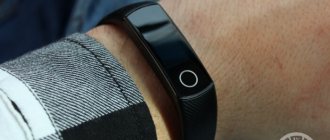The Honor brand was created with an eye on the youth audience and online sales, while its model range differs minimally from the models of the “older” Huawei brand. Thus, the Honor 9, which appeared on sale six months ago, was the “brother” of the Huawei P10, and the new product, the Honor 10, largely replicates the Huawei P20, but costs noticeably less.
Honor 10 line at
Models in the line: 0
Characteristics of Honor 10
- Screen: LTPS, 5.84″, resolution 2280x1080 pixels (19:9), pixel density per inch 432 ppi
- Chipset: 8-core 64-bit HiSilicon Kirin 970 processor, (4 cores ARM Cortex-A73, 2.36 GHz + 4 cores ARM Cortex-A53, 1.8 GHz), i7 coprocessor, NPU (Neural Network Processing) module Unit), HiAI architecture. ARM Mali-G72 MP12 Graphics
- RAM: 4 GB LPDDR4X
- Built-in memory: 128 GB UFS 2.0
- Main camera: 6 MP (RGB, f/1.8) + 24 MP (B/W, f/1.8), hybrid autofocus (phase, contrast, depth of field measurement), LED flash
- Front camera: 24 MP, f/2.0 aperture, fixed focus
- Connectivity/Connectors: 2G, 3G (HSPA+, up to 42 Mbps), LTE Cat. 13 (up to 400 Mbit/s), LTE-FDD b3, b7, b20. Wi-Fi 802.11 a/b/g/n/ac (2.4 GHz + 5 GHz), Wi-Fi Direct, Bluetooth 4.2 LE (BLE, aptX, aptX HD, LHDC), USB Type-C (USB 2.0, OTG), NFC, IR port
- Navigation: GPS/GLONASS/BDS, A-GPS
- Battery: Li-polymer, 3,400 mAh, supports Huawei SuperCharge (4.5 V / 5 A) included
- Case material: aluminum, Gorilla Glass of unknown series
- Operating system: Android 8.1 Oreo with EMUI 8.1 shell
- Dimensions: 149.6x71.2x7.7 mm, weight 153 grams
Design, ergonomics
In the appearance of Honor 10, it is difficult not to notice the continuity with last year’s Honor 9 and the new Huawei P20 Pro. The smartphone inherited the glass design from the previous generation, and the design of the front panel from the current Huawei flagship, where the main detail is the unibrow. Yes, this is the most damned unibrow; almost all smartphone manufacturers have adopted it. Only Sony, HTC and Samsung resist this strange trend. Personally, the cutout above the screen doesn’t bother me at all, I’m already used to it.
If you compare Honor 10 and Huawei P20 Pro/P20 in person, you will immediately notice that the side and top frames of the latter are slightly smaller, and the curves are not so obvious. But holding the Honor 10 in your hands you don’t see this, the screen seems frameless, only the bottom of the chin reminds of the ultrasonic fingerprint sensor, which has been assigned the role of a multifunctional control key.
The design of Honor 10 gives me restrained delight. I don’t want to praise Honor too much, because... There's nothing extraordinary about his appearance, but I really liked his design.
The review features the Honor 10 in Phantom Blue, which has a Northern Lights-style gradient at an angle. In reality, a smartphone almost always looks like a glossy blue, shimmers beautifully, but I rarely observed the “northern lights” effect as in promotional materials.
In terms of connectors and control keys, everything is standard, if not for the presence of a mini-jack for headphones. This is a very rare guest in more or less expensive smartphones in 2022. Moreover, Honor not only left the 3.5 mm jack, but also bothered with a separate DAC; more about this in the section about sound.
Ergonomics.
The dimensions of Honor 10 are pleasing with its compactness; the phone can easily be compared with the Galaxy S9 or iPhone X. The screen area of these smartphones is approximately the same, as are the dimensions, but the weight of Honor 10 is noticeably less. Due to the curved back side, the device rests comfortably in the hand, ergonomics are at a high level.
Honor 10, for the first time among the devices I tested, has implemented face unlock quite well. It works no worse than Samsung or Apple, and if something goes wrong (at night, for example, you can’t see your face), you can always quickly put your finger on the scanner without changing your grip.
I’ll add a few words about the fingerprint scanner. It is not an ordinary capacitive one, but an ultrasonic one. In theory, this means that the image is calculated not in 2D, but in 3D mode, but in practice this only means slightly more accurate operation when fingers are wet or dirty. In my opinion, the Honor 10's scanner is a little slower than the Huawei P20 Pro or Mate 10 Pro that I tested. The difference in speed is not great, but it is there.
⇡#Design, ergonomics and software
Few people today are chasing originality in search of their identity when it comes to the design of smartphones. Reliability and proven solutions, especially if they have already been tested by Apple, are much preferable. Honor 10 has become the latest owner of a cutout at the top of the display - almost exactly the same as the Huawei P20/P20 Pro. Except that instead of a round speaker grille, it has an oval one.
Honor 10 in Glacier Gray color
Moreover, Huawei is not shy about its decision - at the presentation of Honor 10 they compared it with the iPhone X, and the Chinese plainly stated that our smartphone has a much more beautiful insert. Well, maybe so - it’s very difficult to judge the beauty of these controversial solutions, which serve the utilitarian goal of maximizing the expansion of the display.
| The mysterious disappearance of the unibrow in Honor 10 | ||
If you don't like the display being torn by the insert, you can fix it programmatically - in the settings you can choose to fill the status bar with black. In this form, the cutout will merge with the on-screen surroundings on which system information is displayed.
| Honor 10 in black and Phantom Blue | ||
The feature of older Huawei smartphones from 2022 is no longer just a mirrored back panel that needs a case, like a person in the air (otherwise the smartphone turns out to be too slippery and also gets dirty instantly). The main design feature of both Huawei P20 and Honor 10 are unusual color schemes. In addition to black and gray-blue, in this case we got two gradients at once: Phantom Blue (purple-blue) and Phantom Green (purple-green). The test, unfortunately, turned out to be relatively boring, but still beautiful Glacier Gray - despite the name of the color, it is more blue than gray.
Honor 10, front panel: top – cutout with status indicator, front camera and earpiece, bottom – touch “Home” key
The 5.84-inch display (yes, we're in 2022, that's the new normal) is packaged in a body that's just slightly larger than the one we saw on the Honor 9 with its 5.2-inch display. Yes, this is partly a trick - the screen is elongated (19:9 format), and its real area is not as much larger as it seems when looking at the diagonal. But for the most part, such a breakthrough is achieved by reducing the scope. They are noticeable here, but do not interfere much with reaching different parts of the display with your finger. I couldn’t use Honor 10 with one hand - the comfort level is slightly lower than in the case of Honor 9. But there is no fundamental difference.
Honor 10, rear panel: in the upper left corner there are two camera lenses protruding above the body and a single LED flash
And yet, when you look at the dimensions and weight of the smartphone, you notice, if not a feat of engineers, then at least an achievement. Honor 10 weighs two grams less than Honor 9, despite the fact that it not only has a larger display, but also a larger battery. How the developers managed to achieve this using the same materials (glass front and back, metal with small plastic inserts on the edges) is an interesting mystery.
Honor 10, left side: slot for two nano-SIM carrier cards
Honor 10, right side: power and volume/camera shutter keys
The layout of the case is classic - on the left edge there is a slot for SIM cards, on the right - the power key and volume control / shutter release. At the bottom, in addition to the USB Type-C port and the speaker (it is monophonic here, it is not duplicated as a conversational one), you can also find a mini-jack for headphones. Huawei still did not rush headlong into the stormy waters of fashion, ignoring all the laws of common sense. There is no moisture protection - leave at least an analog headphone jack.
Honor 10, top edge: microphone and IR sensor
Honor 10, bottom edge: mini-jack, USB Type-C port, microphone and main speaker
Despite the all-out universal pursuit of how much of the front panel is occupied by the display, Huawei has resolutely left the Home key with a built-in fingerprint sensor on it. And in an unusual format - the scanner itself is ultrasonic and hidden under glass; it feels like an ordinary touch key with vibration as feedback, but it looks like a transitional stage between traditional scanners and those hidden in the display.
This is not the first ultrasound scanner; we have already seen them in the most unexpected devices (like LeEco Le Pro 3) - and, unfortunately, far from perfect. It reacts to touch every time, the percentage of errors is very high - despite the fact that in theory its sensitivity to microdamage to the skin should be lower than that of capacitive sensors. At the same time, you can use the scanner with a wet or dirty finger - it ignores these things. At least it's some kind of plus.
If you wish, you can abandon this method of verifying the owner in favor of facial recognition, but, firstly, an unreliable method is used with only the front camera (you can even deceive it with a photograph), and secondly, how well the system worked in the Huawei P20 Pro, It works so poorly in Honor 10. I don’t know what the reason is, but, as with the fingerprint sensor, the response rate is low. Approximately at the level of ASUS Zenfone 5.
You can use both facial recognition and a fingerprint scanner - just for different purposes. One, for example, to unlock the device, the second - to pay via Google Pay or access your personal space.
Honor 10: EMUI
View all images (24)Honor 10 runs on Android 8.1 Oreo operating system with EMUI 8.1 shell. There are no differences from what we saw in the Huawei P20 Pro in terms of the general operating logic. All I can say is that it works subjectively a little slower with a slightly larger number of errors - but I definitely won’t dare to draw far-reaching conclusions from this about the artificial “slowdown” of Honor in comparison with the flagship smartphone. Well, energy efficiency is completely different - there are no complaints about the platform, it’s all about the LCD screen instead of OLED.
Another small difference is a larger number of pre-installed applications at the start. For each country - its own: for Russia - from some Yandex applications to the Sberbank.Online client.
Screen
Honor 10 received a high-quality IPS screen, typical for the 2022 market, with an aspect ratio of 19:9 and FHD+ resolution. Pixel density per inch 432 ppi. The entire front panel is covered with protective glass Gorilla Glass of an unknown series.
The screen is really high quality - fairly accurate color reproduction, maximum viewing angles and high contrast. It’s difficult to find fault with the Honor 10 display, except that I would like the maximum brightness to be higher; here it is at the level of 450-500 nits. It’s enough in bright sunlight, but after the same Huawei P20 Pro, the screen seems faded.
As in other Huawei/Honor smartphones running EMUI 8.1, in the screen settings you can adjust the color mode and temperature to suit you if you are not satisfied with the two standard presets - bright (DCI-P3 profile) and standard (sRGB profile).
Camera
The main camera of the Honor 10 is one of the few places where the company has saved money, but not as ugly as they did in the Nokia 7 Plus for the same money.
The dual camera received a 16 MP color module (f/1.8) + 24 MP monochrome module (f/1.8). The resolution, compared to the Huawei P20 (12 + 20 megapixels there), has grown, but Honor does not indicate the physical dimensions of the sensors and the size of each pixel. And most likely for good reason.
In reality, the Honor 10 camera is no match for the Huawei P20 camera, the TOP 3 camera phone of 2022. The disadvantage is the lack of optical stabilization, which greatly limits the user when shooting at night, as well as the camera application. But you can easily get good footage with Honor 10.
The front camera is not bad - 24 MP, f/2.0, shoots video in 1080p. Quite good for yourself. Moreover, Honor forgot to squeeze various filters into the camera application a la Snapchat.
How Honor 10 takes photographs (scroll to the right):
The Honor 10 camera software can be criticized for being too thoughtful compared to the Huawei Leica camera, its so-so design and inconvenient access to the main functions. For example, to get to the manual mode, you have to swipe to the More item, and then click on the PRO icon. A tedious task that almost completely discouraged me from shooting with the Honor 10 in manual mode.
The absence of the Leica nameplate and the use of a different camera application in Honor 10 forced the company to come up with a use for the neural units in the Kirin 970 chipset. They did it simply - they took the shooting scene prediction modes from the Huawei P20 Pro/P20 and put them into the AI mode, which works in the Honor 10 camera default. AI-powered photography optimizes scene settings for each shot.
This thing works well; bright, rich shots will be just right for Instagram stories, but mobile photographers will howl at such blasphemy of photography. Thank God, even in finished photos the AI effect can be turned off by pressing one button in the standard gallery. You can see in what form the photo looks better and send your favorite version for publication on social networks.
I don’t even want to talk about modes with augmented reality and portrait lighting in the style of the iPhone X/iPhone 8 Plus. Made for show, it works so-so. However, see for yourself:
Yes, it's tough.
Software
Honor 10 runs on Android 8.1 Oreo with the proprietary EMUI 8.1 shell; the smartphone received Project Treble support, which guarantees a quick update to Android 9.0.
I didn’t notice any special differences in terms of capabilities compared to the Huawei P20 Pro. iPhone X-style gesture controls are in place, Face Unlock too, the unibrow is hidden.
The firmware is very stable, I did not observe any crashes or freezes during a long test. Huawei engineers did a great job optimizing the device.
I received a P20 Pro with early firmware for testing, so I don’t know how things are on the new builds, but Honor 10 has added new animations on the desktop. It became similar to iOS 10, everything is smooth and beautiful.
Always On Display was removed due to the fact that Honor 10 has an LCD screen on which this mode is not very appropriate.
I will repeat my thoughts about the sloppiness of EMUI 8.1. Yes, in Honor 10 on the latest firmware almost everything is good from a visual point of view, but Huawei’s shell is not yet up to par with Samsung Experience in the Galaxy S9.
Results
Honor 10 is a combination of modern technology and style. The Chinese sub-brand has once again released a smartphone that is sure to become a bestseller. Modern design, excellent cameras and fashionable features make this gadget an excellent choice in the segment under 30 thousand rubles.
Pros:
- Gorgeous glass chameleon design.
- Bright widescreen screen.
- Powerful cameras with additional features.
- Smooth operation of the interface and applications.
- Large amount of memory.
- Fast face recognition.
- Availability of NFC, Type-C and IR port.
Minuses:
- Heating and throttling in heavy games.
- Slow fingerprint scanner.
- There is no dust or moisture protection.
Ratings: 4 , average: 4.75
Performance, operating time
The heart of the Honor 10 is the Kirin 970, Huawei's flagship chipset based on the 10 nm process technology. The first smartphones to use it were the Mate 10 Pro/Mate 10, and at the beginning of the year the P20 Pro and P20 were equipped with it.
The chipset is powerful, fast and not particularly hot. It is a serious competitor to the top solutions of Snapdragon and Exynos, and in terms of neural computing it has no equal.
Honor 10 copes with demanding toys no worse than other flagships. Benchmark tests confirm this:
I was very pleased that the company did not skimp on memory, equipping the Honor 10 with UFS 2.0 chips with read/write speeds of 700/200 MB. This greatly improves responsiveness on the desktop, applications, and galleries.
Working hours.
The autonomy of Honor 10 is not record-breaking, but quite decent for a smartphone with a 5.8” IPS bright screen. The 3400 mAh battery lasted me from early morning until late at night, without trying to save power.
Autonomy
Honor 10 has a non-removable lithium-polymer battery with a capacity of 3400 mAh. The smartphone supports proprietary fast charging SuperCharge, with which it charges from 0 to 65% in half an hour, and the battery does not heat up much. In the PCMark battery benchmark, with a screen brightness of 200 cd/m², the smartphone lasted just under 7 hours - this is not the most outstanding result (almost like the Huawei P20); In normal use, the phone should last a day under medium load and up to two days under light use.
4.5
ITC.UA rating
Pros: Design; workmanship; display; performance; quality of daytime images; price
Cons: Battery life could be longer; lack of optical stabilization; lack of moisture protection
Conclusion: As expected, Honor 10 turned out to be a somewhat simplified version of Huawei P20, at a noticeably lower cost; the main question was how far the simplifications went. Fortunately, all of them turned out to be not particularly critical: the camera modules here are weaker (although the image quality remains quite high, and a monochrome mode using a separate module is also present) and there is no optical stabilization, plus the body does not have any dust and moisture protection (which P20 has it). Otherwise, Honor 10 is a productive smartphone with an interesting design and a unique iridescent back cover, an excellent IPS display and a competitive price.
Specifications
Communication, sound
The quality of voice transmission and cellular signal in Huawei/Honor flagships is always at the highest level, I usually use them as an example for other smartphones. Honor 10 is no exception; it’s really nice to make calls and communicate for a long time.
It was not possible to evaluate the sound quality in the headphones - there were no wired headphones at hand. They say that the sound is top-notch, due to a separate 32-bit AK4376A DAC, which is capable of driving any high-impedance fittings or “monitors”.
Wireless sound on Honor 10 is no frills. aptX HD is supported, but for some reason they forgot to add support for the LDAC codec, although as far as I know, certification from Sony is free. Apparently, Huawei thought that Honor 10 was already too cool, so they left LDAC for the flagships - P20 Pro, P20 and Mate 10.
The sound from the Honor 10's speakers is not stereo, which is bad. One speaker at the bottom is not enough for the phone to become a replacement for a wireless speaker. There are no questions about the speaker itself; it is of sufficient quality and loud.
Display options
The smartphone screen has a diagonal of 5.84 inches. Screen resolution is 2280x1080 pixels, their density is 432 ppi. The display of Huawei Honor 10 is made on an IPS matrix. The image on the screen is bright and colorful, the color rendition is oversaturated, but this is noticeable only to specialists. Color rendition can be adjusted and made natural.
There is no layer between the matrix and glass, which improves image quality under high external illumination. The maximum brightness is enough to make it comfortable to view the screen outdoors on a sunny day. At the minimum value, you can read in the dark without straining your eyes. With manual brightness control and white output on the entire screen, these values are 490 and 2.3 cd/m², respectively.
You can adjust the brightness manually or use the automatic setting feature. It works based on the readings of the light sensor and the value set by the slider.
The viewing angles of Honor 10 are large, the color gamut does not shift even with a significant deviation from perpendicular viewing. Color shades are not inverted. When tilted, the black turns purple. The brightness decreases approximately 5 times. The contrast is high, 1500:1.
Multi-touch accepts up to 10 simultaneous touches. There is no flickering of the screen; it is not expected by the type of IPS matrix used.











